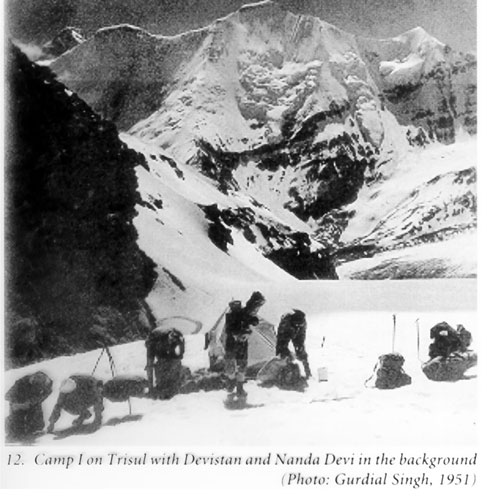|
saLT |
the-south-asian Life & Times July-Sep 2011 |
|
|||
|
Sports Tennis Feature Indian
Military Lt Gen R S Sujlana - A Conversation
Royals in
Uniform Art
Adventure 60
Years of Indian
Travel
|
|
||||
|
Reminiscing Trisul 1951 - A Watershed in Indian Climbing By Gurdial Singh
Sixty years
ago Gurdial Singh climbed Trisul – 23,360 feet. He was
accompanied by Roy Greenwood, Sergeant-Instructor at the Indian Military
Academy, and Dawa Thondup, a Sherpa ‘Tiger’, who had earned renown on
Everest and other major peaks. The ascent of
Trisul was not a first, for it had been climbed twice before, the first time
as early as 1907. Nor was it a peak that presented exceptional technical
difficulties. Yet there is an aspect of the climb that gives it historic
significance. It was the first time that a major peak had been climbed by an
Indian. “It was when Gurdial Singh climbed Trisul in 1951 that the age of
mountaineering for Indians began,” wrote Harish Kapadia, a chronicler of the
Himalayan scene. The Indian Mountaineering Foundation (IMF), which was
established a few years after this climb, recognised it as the ‘beginning of
Indian mountaineering.’ The history of mountaineering in the Himalaya from
around the turn of the nineteenth century, exclusively by foreigners
supported by mountain porters, is a fascinating saga of adventure and
exploration of the unknown. At a time when climbing equipment of the kind
available today was rudimentary and accurate mapping had yet to be
accomplished, it seems incredible that Dr. Tom Longstaff succeeded in
climbing to the summit of Trisul at an elevation of 23,360 feet as early as
in 1907 – which remained an altitude record of summits climbed for the
succeeding 24 years. This was the inspiration that led four of us to make
a bid for Trisul in June 1951 with a happily successful result. We did not
of course realise then that this event would count as a historic first
ascent of a major Himalayan peak by an Indian team, thus also marking the
beginning of Indian mountaineering. It was also significant that three of
the four members had Doon School connections. The Doon School was indeed the
nursery that produced the earliest mountaineers of great distinction. Scarcely had Roy Greenwood and I returned from the
trip to Bandarpunch in 1950 than we started making plans for the following
summer. Having considered various high-altitude treks, we decided on
Trisul(23,360 feet). Greenwood left both the task of forming a party and the
organisation of the expedition to me. The former was readily accomplished.
Two old boys of the Doon School, Surendr Lall and Nalni Jayal, who had long
desired an introduction to the high hills, were invited to join the party.
Their acceptance ,eant that whatever the fate of the expedition might be, we
kindred spirits all, could at least be sure of the lasting satisfaction of
congenial company shared and enjoyed in a mountain venture. The average age
of the part y was 25 and not all of us were certified climbers.
|
|||||
|
Copyright © 2000 - 2011 [the-south-asian.com]. Intellectual Property. All rights reserved. |
|||||
